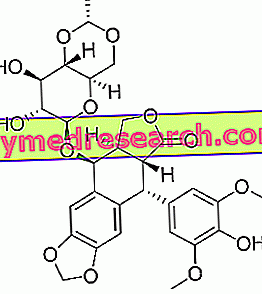Etoposide is an anticancer drug whose structure derives from the natural podophyllotoxin molecule. Podophyllotoxin is the main resinous component of the podophyllin, a substance isolated from the dry roots of the herbaceous plant Podophyllum peltatum .

Etoposide - Chemical Structure
Indications
For what it uses
Etoposide can be used - alone or in combination with other anticancer drugs - in the treatment of:
- Small cell lung cancer;
- Testicular cancer;
- Lymphomas;
- Acute non-lymphatic leukemia;
- Ewing's sarcoma.
Moreover, etoposide can be used in preparation therapy for a hematopoietic stem cell transplant (the progenitor cells that generate blood cells).
Etoposide can also be used in combination with radiotherapy or after surgical removal of the tumor.
Warnings
The administration of etoposide should only be performed by personnel experienced in the administration of anticancer agents and only under the strict supervision of an oncologist.
When the drug is administered intravenously, extravasation from the injection site should definitely be avoided.
During etoposide therapy, liver function, renal function and blood cell counts should be constantly monitored.
Patients with low plasma albumin concentrations are exposed to a higher risk of toxicity from etoposide.
Etoposide can cause fatigue and exhaustion, therefore it is recommended to avoid driving vehicles or using machines until the symptoms have disappeared completely.
Interactions
The simultaneous intake of etoposide and other anticancer drugs (such as, for example, 5-fluorouracil and cyclophosphamide ) may increase the myelosuppressive action (bone marrow suppression) of etoposide itself.
Organo-platinum antitumor agents (such as cisplatin, carboplatin and oxaliplatin ) decrease the elimination of etoposide, which can produce harmful effects. In case a combination of these drugs is needed, it is necessary to allow at least two days between the administration of etoposide and the administration of the anti-tumor platinum organ.
Etoposide can increase the anticoagulant action of drugs like warfarin .
Phenylbutazone (a non-steroidal anti-inflammatory drug), sodium salicylates and acetylsalicylic acid can increase the action of etoposide, causing potentially dangerous effects.
The concomitant administration of etoposide and ciclosporin (a drug used in the prevention of rejection in transplants) may increase the plasma concentration of etoposide exponentially, thus causing an increase in adverse effects. The etoposide dose should therefore be reduced by at least 50% when it is given in combination with ciclosporin.
You need to tell your doctor if you are taking any type of medication, including over-the-counter, homeopathic and / or herbal products.
Side effects
Etoposide can induce many side effects that vary depending on the amount of drug administered, depending on the route of administration chosen and the patient's condition. Furthermore, there is also a large variability in response to chemotherapy between individuals. For this reason, the type of side effects and the intensity with which they occur can vary greatly from one patient to another.
The following are the main side effects that may arise following treatment with etoposide.
Myelosuppression
Treatment with etoposide may cause myelosuppression. This suppression leads to a reduction in blood cell production (reduced hematopoiesis) which can lead to:
- Anemia (decrease in hemoglobin blood levels), the main symptom of the onset of anemia is the feeling of physical exhaustion ;
- Leukopenia (decreased white blood cell levels), with increased susceptibility to contraction of infections ;
- Plateletopenia (decrease in the number of platelets), this leads to the appearance of bruising and abnormal bleeding with an increased risk of bleeding .
Carcinogenicity
Cases of acute leukemia and promyelocytic leukemia have been reported following treatment with etoposide. More rarely, cases of tumor lysis syndrome have been reported, sometimes with fatal outcomes.
Allergic reactions
Ethoposide can trigger allergic reactions in sensitive individuals. The symptoms that can occur are fever, chills, tachycardia, bronchospasm, dyspnea and hypotension. If these symptoms occur, you should immediately inform your doctor, as it may be necessary to stop therapy and to administer adrenaline, antihistamines and corticosteroids.
Nervous system disorders
Etoposide can cause fatigue, drowsiness and asthenia . Peripheral neuropathy has also been observed, which can potentially be aggravated by combination therapy with vincristine (another anticancer medicine).
Eye disorders
Etoposide can cause optic neuritis (inflammation of the optic nerve) and can cause temporary blindness .
Cardiac disorders
Treatment with etoposide can cause arrhythmias and myocardial infarction .
Vascular pathologies
When etoposide is administered intravenously, it has been observed that an excessive infusion rate can cause hypotension . This effect can be decreased by reducing the infusion rate.
Gastrointestinal disorders
Treatment with etoposide can cause nausea and vomiting . They are very common side effects that can easily be kept under control with the use of anti-emetic (antivomit) drugs.
Abdominal pain, diarrhea, stomatitis, mucositis, oesophagitis, anorexia and taste changes may also occur.
Hepatobiliary disorders
Treatment with etoposide can cause liver function dysfunction and increase plasma bilirubin and alkaline phosphatase concentrations.
Alopecia
Treatment with etoposide can cause hair loss. In any case, this is a temporary side effect that should be resolved shortly after the end of chemotherapy.
Skin and subcutaneous tissue disorders
After taking etoposide skin rashes, hives, skin pigmentation, skin rash and itching may occur.
Other side effects
Other side effects that may occur following etoposide therapy are:
- Infertility;
- Temperature;
- Chills;
- Tachycardia;
- Redness in the face;
- Cyanosis (bluish discoloration of the skin and mucous membranes);
- Facial edema;
- Cold sores;
- breathlessness;
- Hypotension or hypertension;
- Pneumonia;
- Stevens-Johnson syndrome (a variant of polymorphic erythema).
Overdose
There is no antidote for overdose with etoposide. The effects deriving from an excessive drug intake are myelotoxicity, metabolic acidosis, mucositis and severe liver toxicity.
Action mechanism
Etoposide is one of the anticancer agents of type II topoisomerase inhibitors. Topoisomerase II is an enzyme capable of cutting and welding the two strands that make up DNA and plays a fundamental role in the process of cell replication.
By blocking this enzyme, etoposide is able to interrupt cell division. If the cell is no longer able to divide, then it faces the programmed cell death mechanism called apoptosis .
Moreover - although the main action of etoposide is to inhibit topoisomerase II - it seems that it is also able to bind to the tubulin preventing it from carrying out its action. Tubulin is the protein that constitutes the mitotic spindle, an indispensable structure for the formation of daughter cells during mitosis (ie cell reproduction).
The alteration produced by etoposide during the division of the mother cell into the corresponding daughter cells, leads the cell to apoptosis.
Mode of Use - Posology
Etoposide is available for both intravenous and oral administration.
For intravenous administration, etoposide appears as a clear liquid. For oral administration, however, it is found in the form of light pink capsules; different dosages are available.
Intravenous administration can occur in three different ways:
- Through a cannula (a thin tube) that is inserted into a vein of an arm or hand;
- Through a central venous catheter that is inserted subcutaneously into a vein near the clavicle;
- Through the PICC line ( Peripherally Inserted Central Catheter ), in this case, the catheter is inserted into a peripheral vein, usually of an arm. This technique is used for the administration of anticancer drugs for a prolonged time.
As for the capsules, these should be taken without chewing.
The dosage must be established by the oncologist according to the type of cancer to be treated, depending on whether the drug is administered as a single agent or in combination with other anticancer drugs, depending on the method of administration chosen and on the conditions and the situation clinical of the patient.
For intravenous administration, however, the usual dose is 60-120 mg / m2 of body surface area, to be administered once a day.
The maximum dose of etoposide - which can be administered intravenously - should not exceed 650 mg / m2 of body surface area per therapy cycle.
For oral administration, the dose usually used is 100-200 mg / m2 of body surface area, to be administered once a day.
In patients with renal and / or hepatic impairment an adjustment in the dose of the drug administered may be necessary.
Pregnancy and breastfeeding
Studies conducted on animals have shown that etoposide is teratogenic. Therefore, the drug should not be used during pregnancy.
Furthermore, since the genotoxicity of etoposide has been highlighted, it is essential to take precautions - by both sexes - to avoid possible pregnancies. Precautions must be taken both during treatment and for a period of at least six months after the end of the treatment.
Mothers on etoposide therapy should not breast-feed.
Contraindications
The use of etoposide is contraindicated in the following cases:
- Known hypersensitivity to etoposide or to other podophyllotoxin derivatives;
- In case of severe liver dysfunctions;
- In case of severe renal dysfunction;
- Pregnant;
- During breastfeeding.



